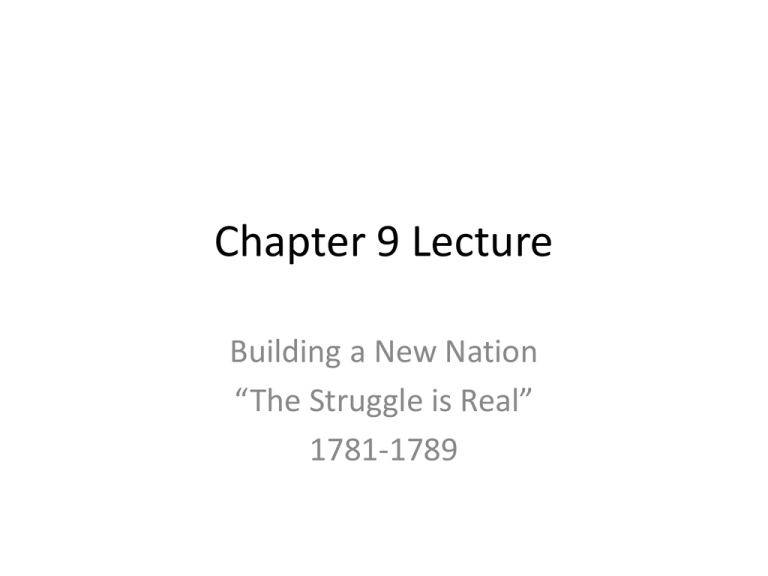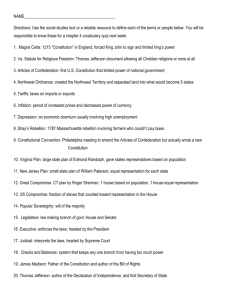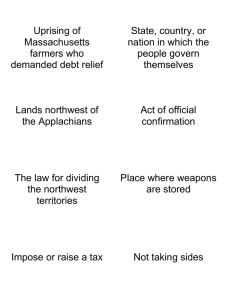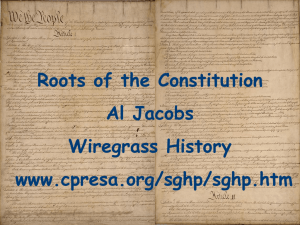File
advertisement

Chapter 9 Lecture Building a New Nation “The Struggle is Real” 1781-1789 State Governments Each state set up its own written plan of government (constitution) • Characteristicsofthesenew governments: – Separation of powers: power was typically split between 3 branches of government – Property requirements were typical for voter eligibility • – Many states included bill of rights that outlined basic freedoms (religion, trial by jury, etc.) • • Virginia Statue for Religious Freedom by Thomas Jefferson Government was set up based upon republicanism (power comes from the people) • – Debate over what republicanism would look like Articles of Confederation 1st national government of the United States Government could: – Conduct foreign policy, borrow money, make treaties • Created a central government with limited power – Unicameral congress – No executive branch or court system – No power to tax – Could not regulate trade Other Problems – 9 votes out of 13 to pass laws – All states regardless of size had one vote – All 13 states must agree to amend the Article Northwest Ordinances Land Ordinance of 1784 established principle that territories could become states as their populations grew • LandOrdinanceof1785:set up system for surveying and selling land in Northwest • – Section set aside for public education • Northwest Ordinance of 1787: set up the system for territories to enter the union as new states • – Banned slavery in the Northwest Territory • 1) British built forts in the west, disrupted trade, and armed Natives • 2)Spain banned American shipping along the Mississippi in 1784 • 3) France demanded repayment of loans • 4) Barbary Pirates harassed American shipping Shay’s Rebellion • Following the American Revolution the economy suffered a postwar depression – Particularly hard hit were farmers • Shay’s Rebellion (1786-87) Daniel Shay veteran of the revolution and farmer in Mass. led a rebellion of poor farmers – Demands: lower taxes, end of foreclosures, paper $, end of imprisonment for debt • Government was TOO WEAK to put the rebellion down – Increased calls for a stronger central government Creating A New Government • Growing demand to address the problems facing the nation (intl trade, finances, interstate commerce, foreign relations, & internal unrest) • Annapolis Convention(1786): 5 states attend to discuss trade and commerce – Plan to meet up in Philly in 1 year • Constitutional Convention (1787) meets for the purpose of revising the Articles – 55 delegates sent “for the sole and express purpose of revising the Articles of Confederation” – Very quickly they decided to create an entirely new stronger central government Compromises of the Convention Big issue at the convention was about representation in Congress • James Madison introduced the Virginia Plan (Large State Plan) – Bicameral (2 house) legislature – Representation would be based on population size • New Jersey Plan was favored by the small states – Unicameral (1 house) legislature – Each state would have equal representation Roger Sherman introduced the Great Compromise – Bicameral legislature – Upper house (Senate) 2 representatives per state • – Lower house (House of Reps) based on population Compromises Over Slavery Debate over whether slaves should be counted in state population? • 3/5th Compromise: slaves would be counted 3/5 of a person when deciding representation in the House of Reps. • Slave trade allowed to continue until 1808 Although the word “slave” or “slavery” was not used in the Constitution, the institution of slavery was very much protected by the original document DEBATE OVER RATIFICATION • Federalists: supporters of the Constitution and a strong central government Anti-Federalists: critics of the Constitution and favored a weak central government – Favored state rights • The Federalist Papers(85 essays) written by James Madison, Alexander Hamilton, & John Jay to persuade people to support ratification of the Constitution • Guarantee of a Bill of Rights helped achieve ratification – Enumerated individual rights and explicitly restricted powers of the fed govt. • • In 1789 GeorgeWashington takes office as the nations 1st President STUFF YOU SHOULD KNOW ABOUT THE CONSTITUTION! 1. The Constitution set up a government based upon popular sovereignty – Power is in the hands of the people 2. Separation of powers between the 3 branches 3. The Constitution set up a division of power between the national and state government (Federalism) 4. Constitution would be “the supreme law of the land” 5. Presidents would not be elected directly by the voters- wanted to limit excessive popular influence – Feared too much democracy would lead to mob rule – Created the electoral college








